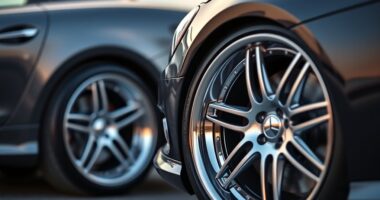Your M270 2.0T ECU is designed with built-in safety limits to protect your engine’s internals from overboosting, excessive fueling, or ignition misfires. With modest tuning, you can safely push performance up to around 20-30 horsepower above stock without risking damage. Going beyond these bounds increases internal stress and may harm pistons, valves, or the turbo over time. To maximize gains while maintaining reliability, it’s essential to understand the factory constraints and consider upgrades—more details await.
Key Takeaways
- The stock ECU limits boost, fueling, and ignition to protect internal components, restricting aggressive tuning on stock internals.
- Modest power gains (~20-30 HP) are achievable safely within factory ECU safety margins.
- Pushing beyond factory limits risks damaging pistons, valves, turbo, and other internal parts.
- Upgrading components like pistons and intercoolers can safely increase internal stress thresholds.
- Incremental tuning with monitoring helps maximize performance while preserving long-term internal durability.

The ECU (Engine Control Unit) in the M270 2.0T engine has built-in limits to guarantee reliability and safety, but these restrictions can also throttle your tuning potential. When you consider ECU tuning, you’re aiming to unlock more power, better throttle response, and improved overall performance. However, the stock ECU is designed with safety margins that protect the engine’s internal durability, meaning pushing the limits risks exceeding those safeguards. Understanding how far you can go without compromising internal durability is essential for a successful upgrade.
The stock ECU’s safety limits protect internal durability but can restrict tuning potential.
The factory ECU sets parameters to prevent overboosting, excessive fueling, and high ignition timing that could damage internal components. While tuning can modify these parameters for more aggressive power delivery, there’s a fine line between gains and risking internal integrity. The stock internals are engineered to handle a specific level of stress, and exceeding those limits may lead to accelerated wear or catastrophic failure over time. So, before you start tuning, it’s vital to know what the engine can handle on its stock internals.
When you tune the ECU, you’re effectively increasing boost pressure, adjusting fueling maps, and advancing ignition timing. These modifications can push the engine beyond its original safety margins, but doing so too aggressively can jeopardize internal durability. Many tuners find that modest gains—around 20-30 horsepower—are achievable without significant internal risk, provided the tune remains within the engine’s mechanical limits. However, aggressive tuning or high boost levels may accelerate wear on pistons, valves, and the turbocharger, especially if the engine isn’t reinforced or upgraded. Remote hackathons provide a collaborative environment where such tuning experiments can be safely tested and shared with community feedback.
To safely maximize performance while maintaining reliability, you should consider incremental ECU tuning. This approach allows you to monitor the engine’s response and verify internal components aren’t overstressed. Upgrades like stronger pistons, upgraded intercoolers, and exhaust systems can also extend the limits of what the stock internals can handle. Remember, the key isn’t only about increasing power but doing it within the boundaries that preserve internal durability. Pushing the engine beyond these limits might give you short-term gains but can lead to long-term damage and costly repairs.
Frequently Asked Questions
Can the ECU Be Tuned Beyond Stock Limits Safely?
You can tune your ECU calibration beyond stock limits, but it requires careful adjustments to fuel pressure and other parameters. Pushing the ECU too far can cause engine damage or reliability issues, so it’s essential to use professional tuning services. Properly calibrated fuel pressure ensures safe power gains, but always stay within safe limits to avoid risking your engine’s internals. Moderation and expert advice are key for a safe, effective tune.
What Are the Signs of ECU Overreach or Damage?
Ever wondered if your ecu calibration is pushing too far? You might notice signs like rough idling, misfires, or inconsistent acceleration, which indicate sensor calibration issues or ecu overreach. Keep an eye on your boost levels, check engine light, and fuel economy. If you experience these, it’s a sign you’ve pushed your stock internals and ecu beyond safe limits. Always monitor these signs to prevent damage and guarantee ideal performance.
How Does Fueling Affect ECU Limits on Stock Internals?
Fueling plays a vital role in ECU limits, as proper fueling optimization guarantees your engine runs safely within stock internals. When you adjust or optimize fueling through ECU calibration, you can increase power without risking damage. However, over-fueling or aggressive tuning might push the ECU beyond its limits, causing issues like knocking or damage. Always balance fueling carefully to maximize performance while maintaining engine safety.
Are There Hardware Upgrades to Increase ECU Capacity?
Ever wonder if hardware upgrades can push your ECU further? The answer is yes—turbo upgrades and a high-efficiency intercooler can release more power and help you tap into your ECU’s potential. These modifications improve airflow and cooling, allowing for safer, higher boost levels. While they don’t directly increase ECU capacity, they create a more robust setup that lets your engine perform at its best without risking stock internals.
How Does Ambient Temperature Impact ECU Performance Limits?
Ambient influence plays a significant role in ECU performance limits, as temperature thresholds affect how your engine responds. When ambient temperatures rise, the ECU may limit power to prevent overheating, reducing performance potential. Conversely, cooler conditions allow the ECU to operate more aggressively within safe limits. You should monitor temperature thresholds closely, understanding that high ambient temperatures can restrict tuning options and overall engine efficiency.
Conclusion
So, with a bit of tuning magic, you can push your M270 2.0T quite far beyond stock limits—think of it as giving your ride a turbocharged dose of the 21st century’s best. Just remember, don’t forget your digital toolkit, because pushing too hard without proper upgrades is like trying to ride a horse in a rocket race—you might get there, but it’s not without risk. Tread wisely, and keep your ride running like a well-oiled DeLorean.










